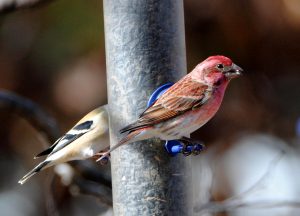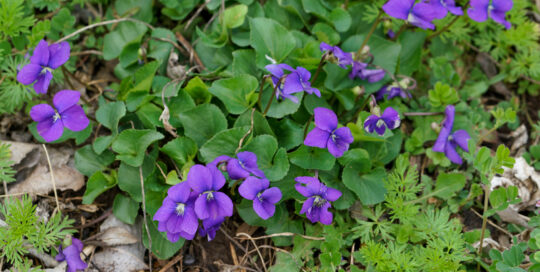Gardening for Birds – An Overview
Views: 8461

I’m a birder, so I do everything I can to encourage birds to visit my yard. Birds, like people, need a few basic things to survive and thrive. If you provide them with these things, they’ll flock to your landscape and garden. In this post, I’ll give you a basic overview of the four things to provide our feathered friends when you are gardening for birds. I’ll also mention a great opportunity happening this month to count the birds in your yard to help out science.
Birds need four things:
- Food
- Water
- Habitat/shelter
- Nesting areas (some people might include this as habitat/shelter, but I like to talk about it separately)
Food
It’s easy to attract birds by providing them with an easy food source. Food is energy; easy food is easy energy. Bird feeders are perhaps the easiest way to attract birds. You can buy bird food (sunflower seeds, wild bird mixes, suet, and others) at local stores or even order it online. But not all birds will be excited to eat your free bird food. Many birds prefer to eat insects, others prefer fruit or nectar, and predators will go after rodents, other birds, or anything else they can catch that might be a tasty meal, like snakes (Yum! Or not…). So, the more food varieties you have in your yard, the more birds you’ll have, too. Think about adding plants, shrubs, and trees that produce seeds, berries, fruit, and nuts to your landscape. While we may consider many bugs and caterpillars to be pests, they are dinner for many birds. There are many ways to encourage insects in the yard and garden; it largely depends on your tolerance level for bugs and the things they eat. Fruit trees will attract orioles. And if you love hummingbirds (and who doesn’t?), you’ll want to plant hummingbird-attracting flowers.
Water
Whenever I am out watering on a hot July or August day, I’ll spray some water up into the trees. The birds love it, and some actually fly to the area when they see I’m doing it. They’ll hop around in the trees while getting a quick drink, taking a bath in the water dripping off the leaves, or perhaps cooling down. Water features of any sort will attract birds. Ponds, fountains, water gardens, birdbaths… Just ensure the water feature is bird friendly, with perches that enable birds to land and takeoff without getting trapped. On freezing days, any unfrozen water source can be a big draw.
Habitat/Shelter
Different birds need different habitat. Some are well adapted to urban environments and yards, others need woods, or marshes, or deserts, or fields. Many birds are pretty specialized, and you aren’t likely to see birds outside their native habitats unless they are migrating. So, the more variety you have in your landscape, the more birds you are likely to have. If you have nothing but a manicured lawn, you will have fewer birds than someone with trees, shrubs, a wildflower field, a pond, and/or a brush pile, for example. Birds need places to hide, to perch, and to find bugs and other food and water. I’m lucky because my property has a pond, woods, and an area of open grass. I have birds that specialize in all these areas: ducks on the pond, woodpeckers in the trees, and Field Sparrows in the open areas. To give you another example, a former residence had orioles because there was a mature hackberry tree next door. That hackberry was good habitat for orioles, providing food (hackberries), shelter, and a perfect perch to sit and sing to attract a mate, which leads to the next topic…
Nesting Areas
I put out a new bluebird nest box (also called a birdhouse or nesting box) last year, and it took only a day for my Eastern Bluebirds to discover it. While they didn’t successfully hatch any young last year, they have done so in other boxes in other years. Nest boxes are not just for bluebirds; any bird that uses a cavity (typically a hole in a tree) to nest might use one. You can purchase wren boxes, bluebird boxes, owl houses, and woodpecker houses or build your own from plans provided on the Internet. Putting up nest boxes is one way to attract birds to your garden. Planting shrubs and leaving dense, protected areas in the landscape can also provide good nesting areas. I also leave dead trees standing in areas they aren’t likely to fall and cause damage or hurt someone.
So, there you have the 30,000-foot overview of gardening for birds. I’ll get into more specific details in later blogs.
Finally, the Great Backyard Bird Count (GCCB) will be happening this month, February 17-20th. This is an opportunity to count the birds you see in your yard over a three day period, and submit that information to a database that is used to track bird numbers, species, and populations. It’s important data for science, and your input is needed to make it as comprehensive as possible. Last year, over 160,000 checklists were submitted with over 18,000,000 birds counted. With your help, they’ll do even better this year. It’s not difficult to participate; you don’t need to be an avid birder, and it can be quite fun for everyone involved. Here is link for more information: http://gbbc.birdcount.org/
Meet Leslie Miller
Leslie Ann Miller shares 3.5 acres in rural Oklahoma with birds, butterflies and wide variety of animals. She is currently transforming her yard with plantings…
Leslie's Recent Posts

Early spring is time to plant native spring ephemerals






